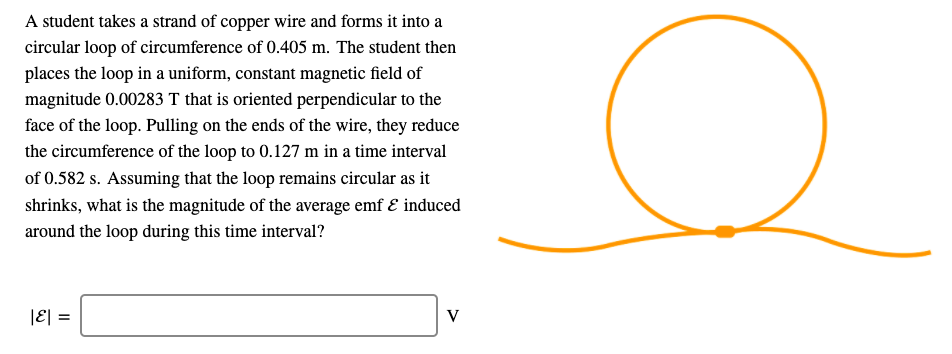A student takes a strand of copper wire and forms it into a circular loop of circumference of 0.405 m. The student then places the loop in a uniform, constant magnetic field of magnitude 0.00283 T that is oriented perpendicular to the face of the loop. Pulling on the ends of the wire, they reduce the circumference of the loop to 0.127 m in a time interval of 0.582 s. Assuming that the loop remains circular as it shrinks, what is the magnitude of the average emf & induced around the loop during this time interval? |ε| = V
A student takes a strand of copper wire and forms it into a circular loop of circumference of 0.405 m. The student then places the loop in a uniform, constant magnetic field of magnitude 0.00283 T that is oriented perpendicular to the face of the loop. Pulling on the ends of the wire, they reduce the circumference of the loop to 0.127 m in a time interval of 0.582 s. Assuming that the loop remains circular as it shrinks, what is the magnitude of the average emf & induced around the loop during this time interval? |ε| = V
Related questions
Question

Transcribed Image Text:A student takes a strand of copper wire and forms it into a
circular loop of circumference of 0.405 m. The student then
places the loop in a uniform, constant magnetic field of
magnitude 0.00283 T that is oriented perpendicular to the
face of the loop. Pulling on the ends of the wire, they reduce
the circumference of the loop to 0.127 m in a time interval
of 0.582 s. Assuming that the loop remains circular as it
shrinks, what is the magnitude of the average emf & induced
around the loop during this time interval?
|ε| =
V
AI-Generated Solution
Unlock instant AI solutions
Tap the button
to generate a solution